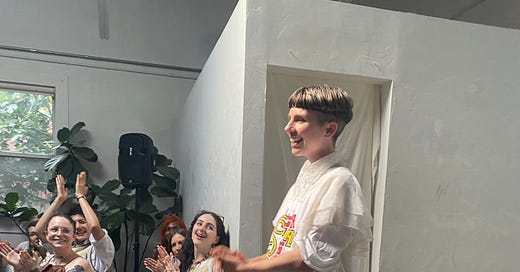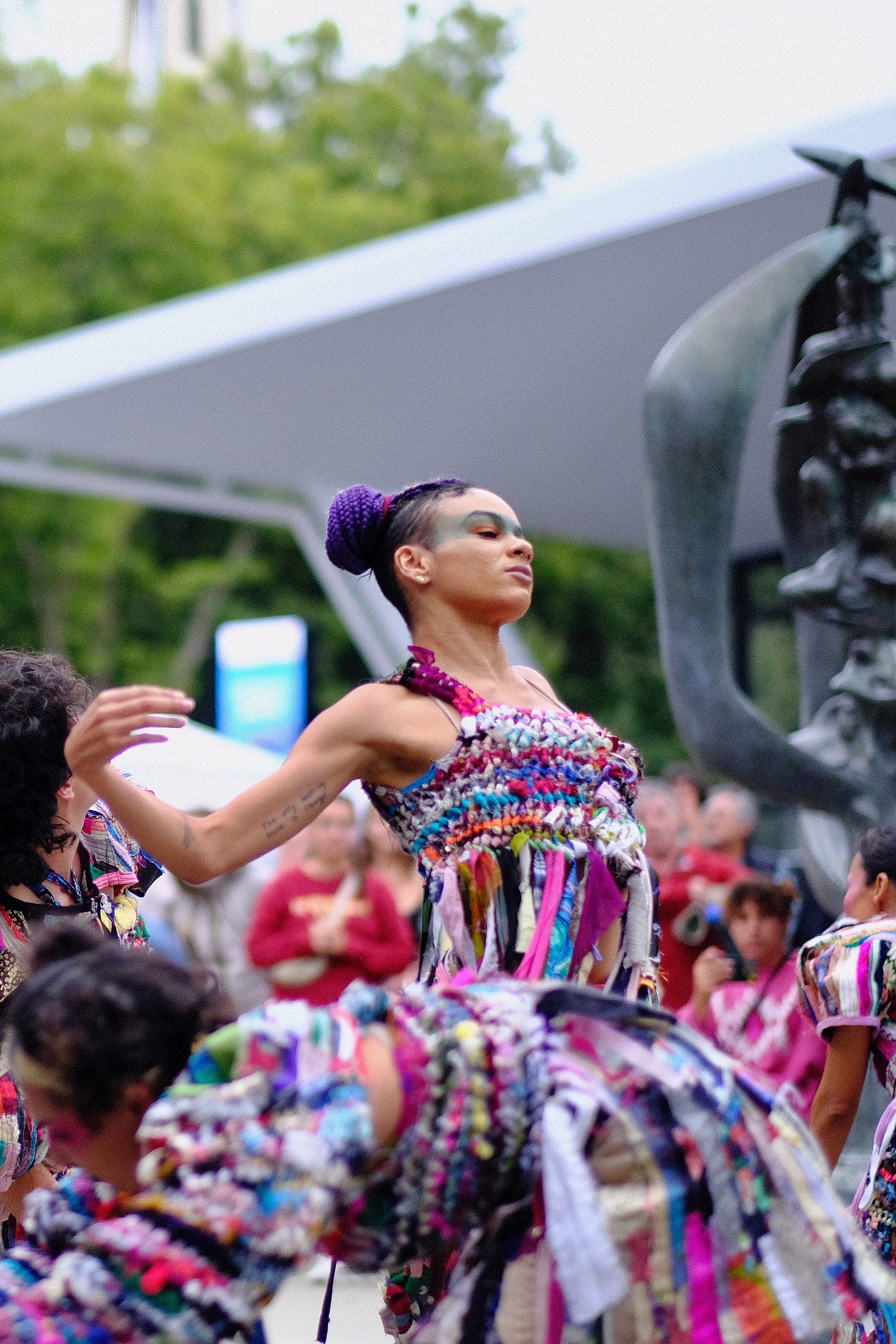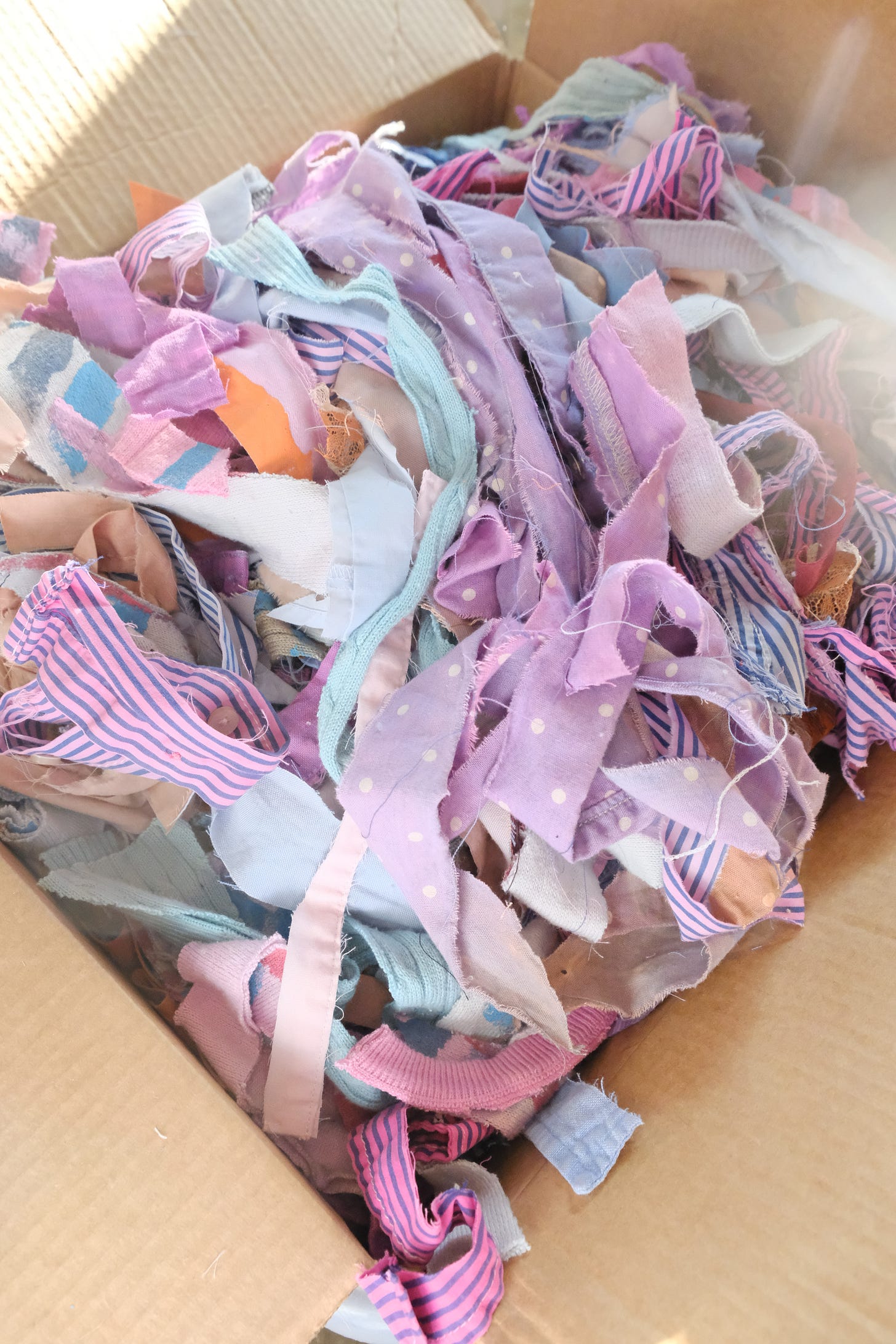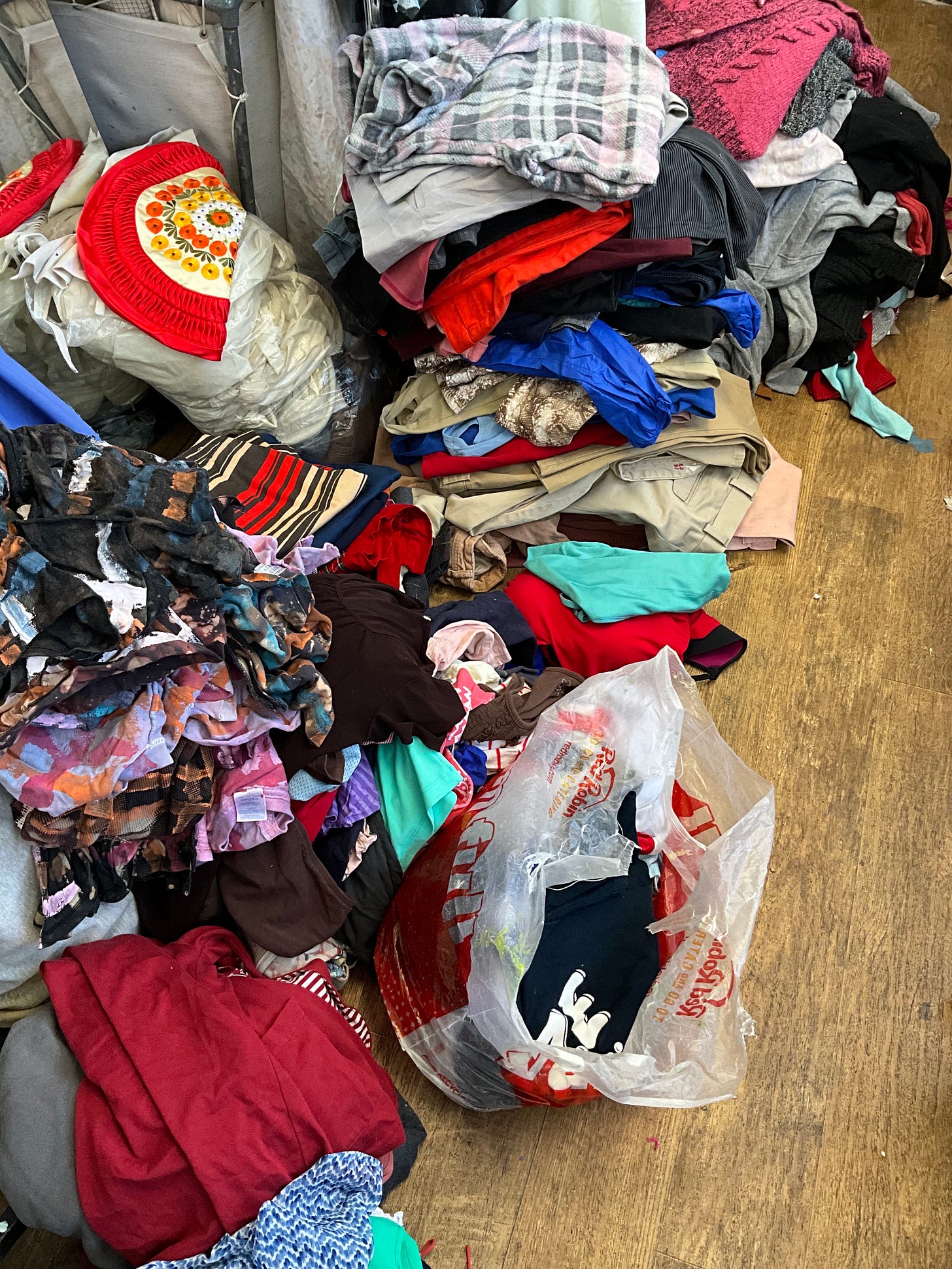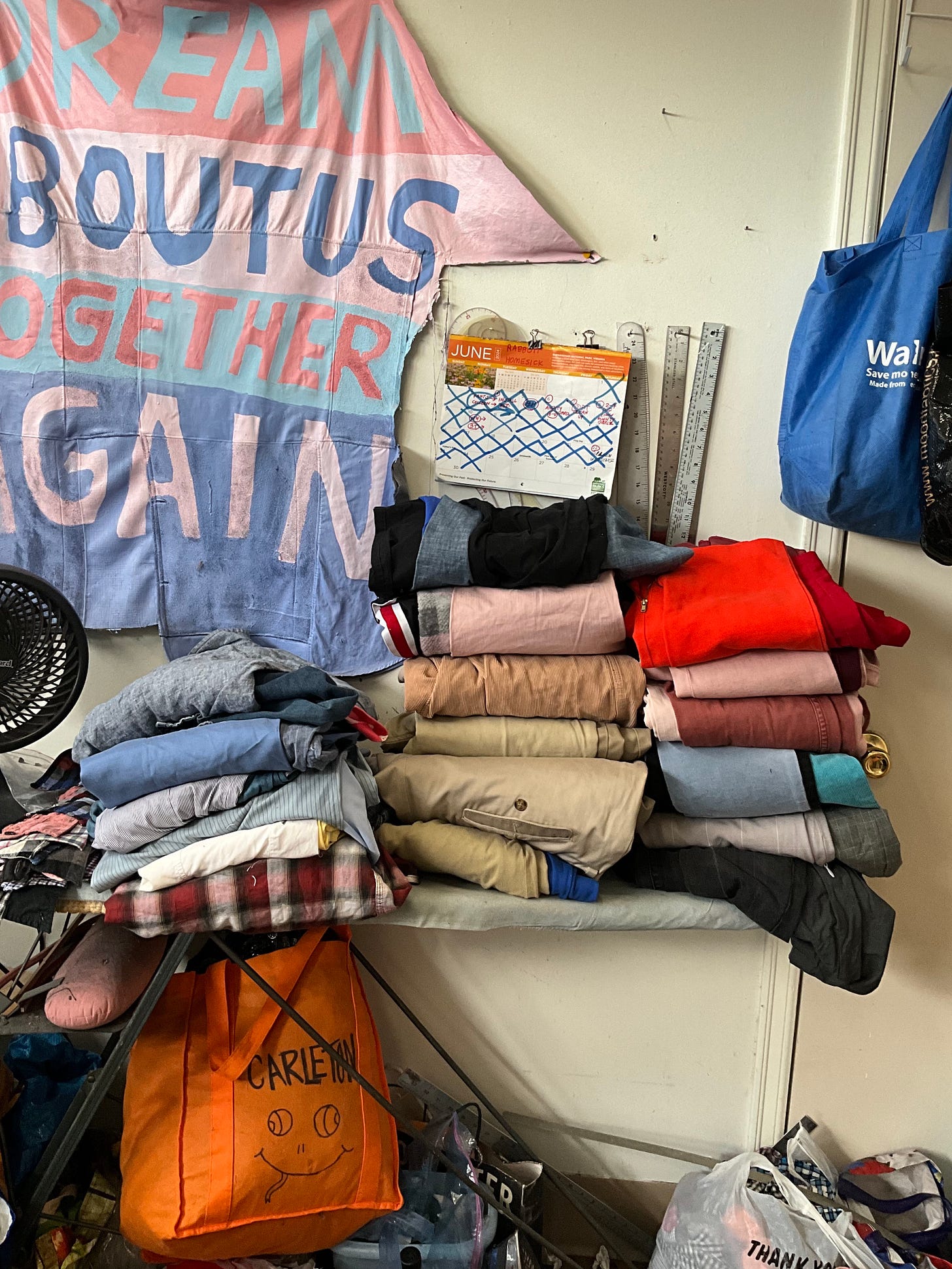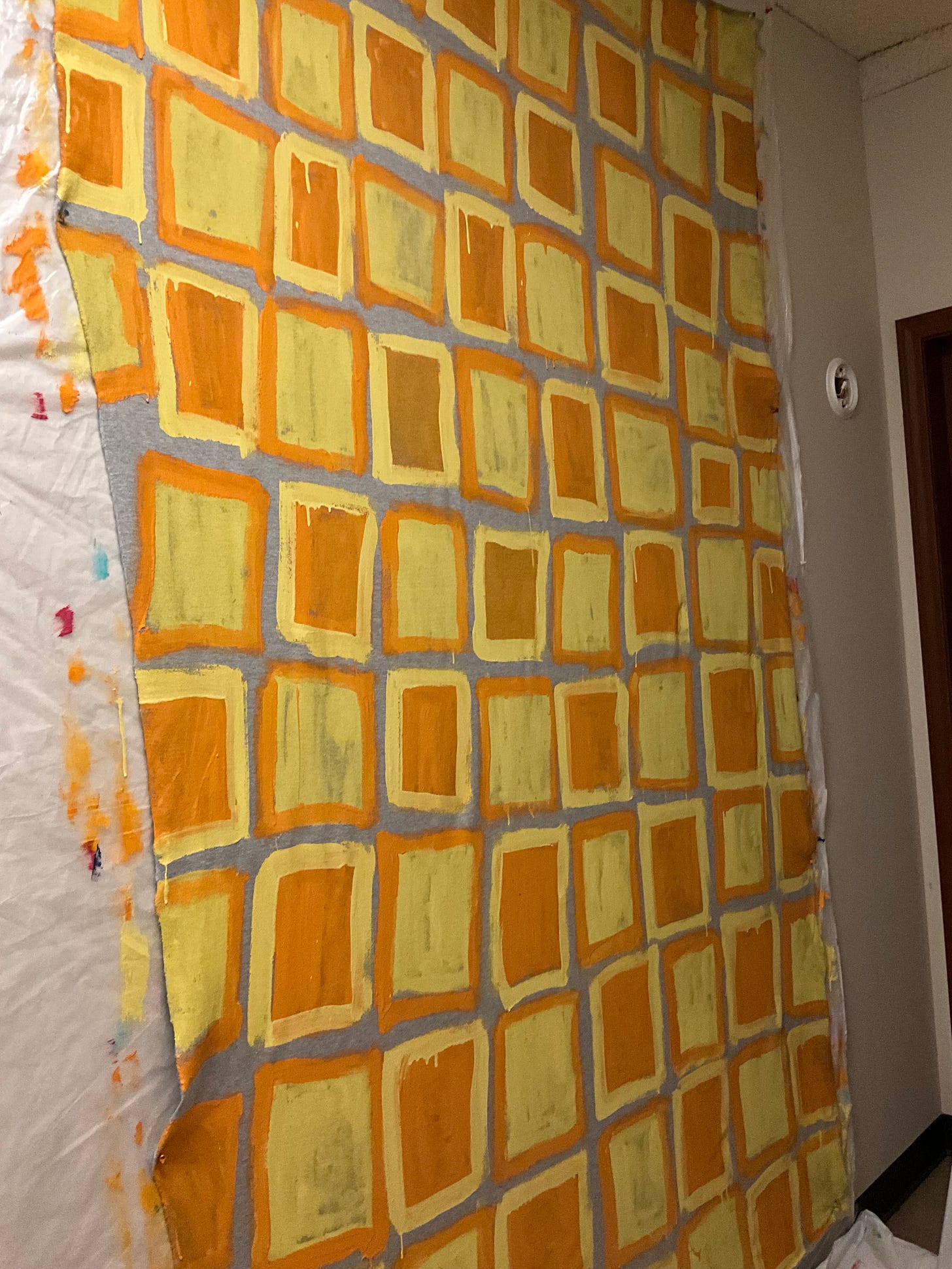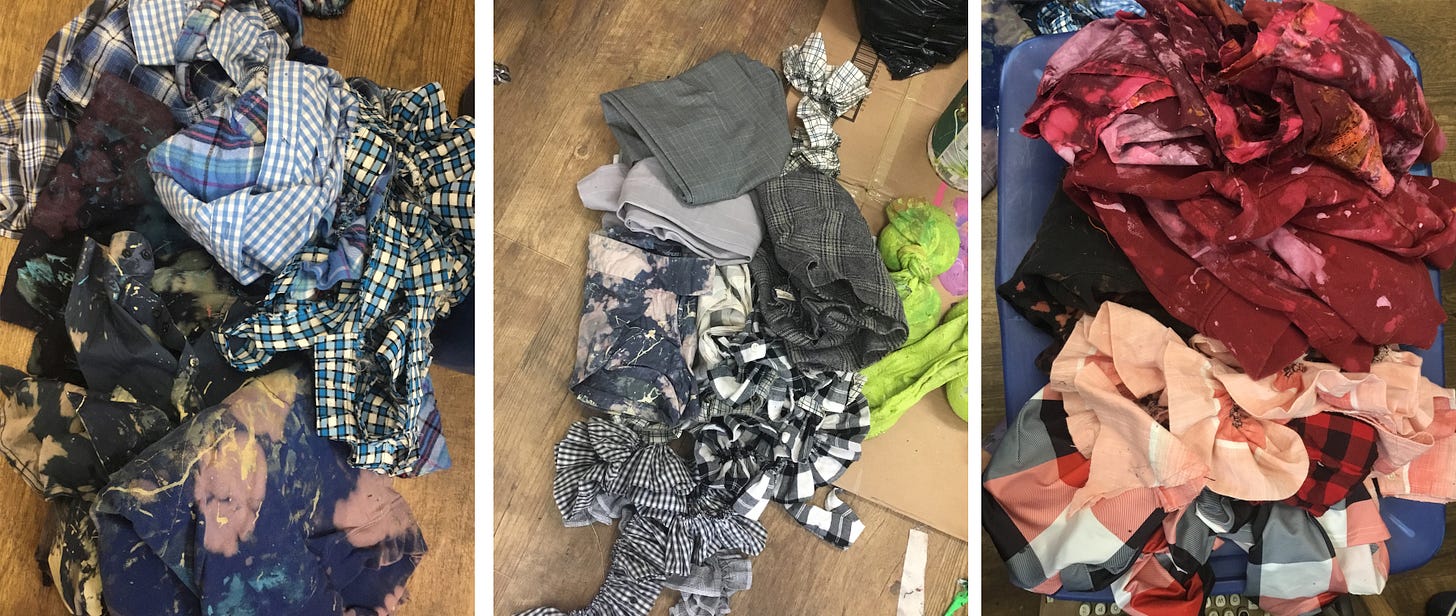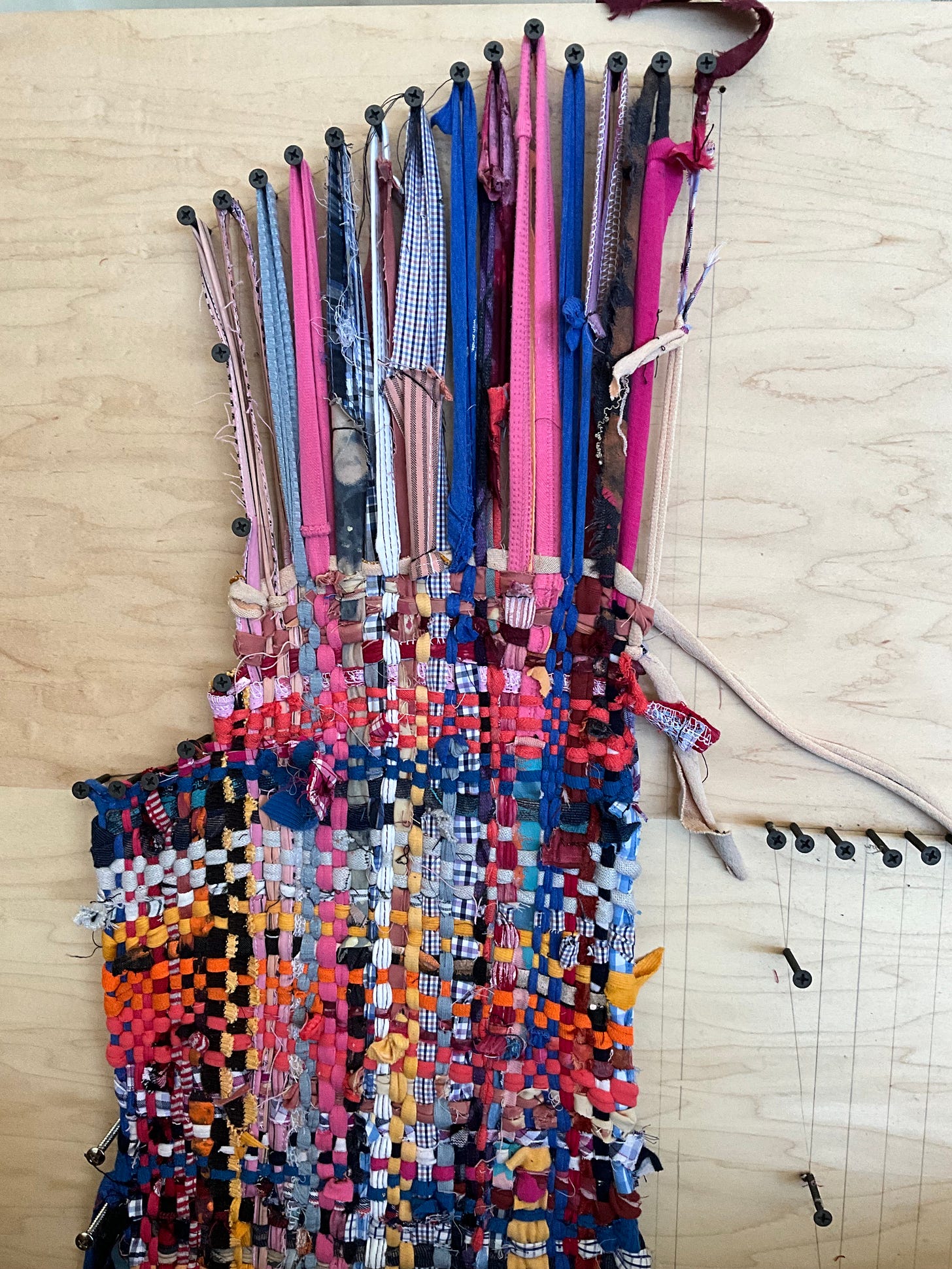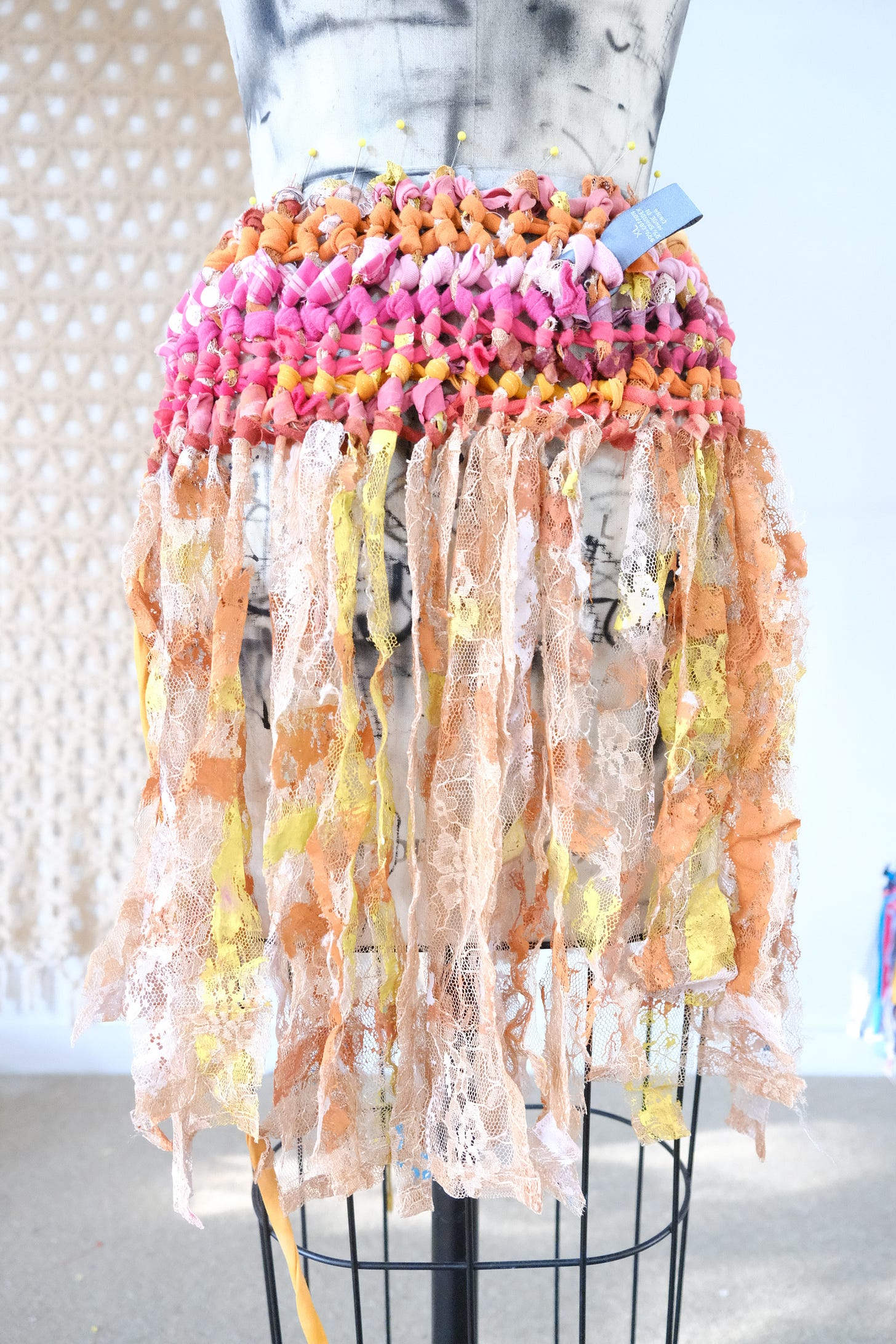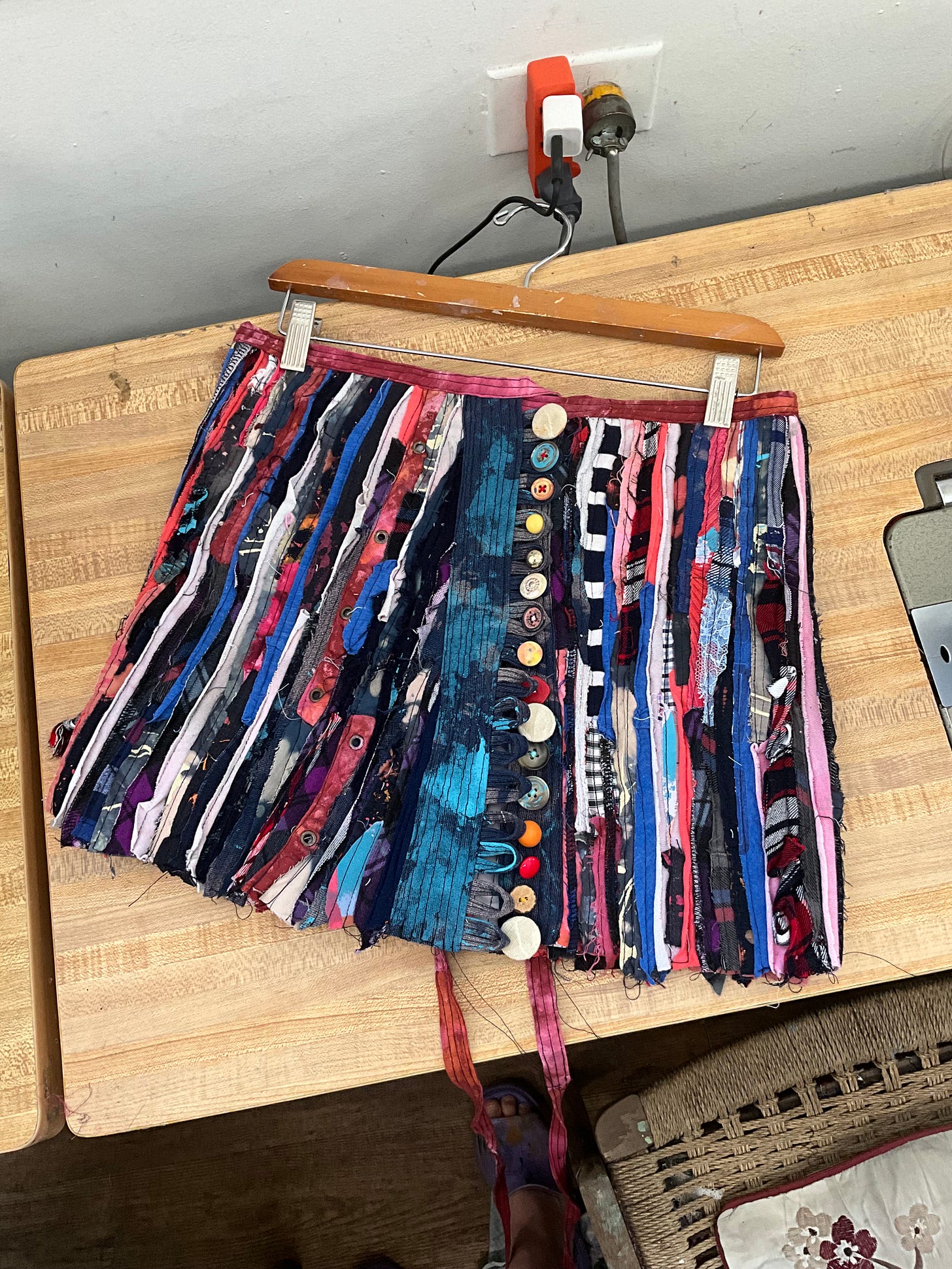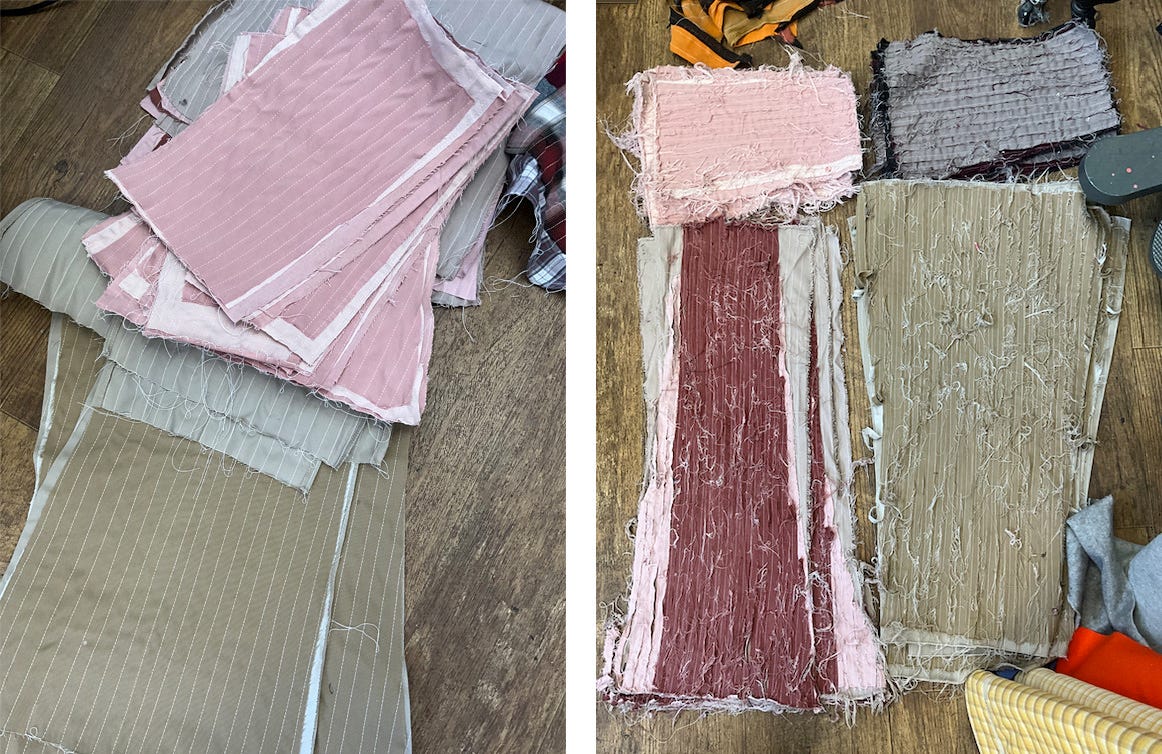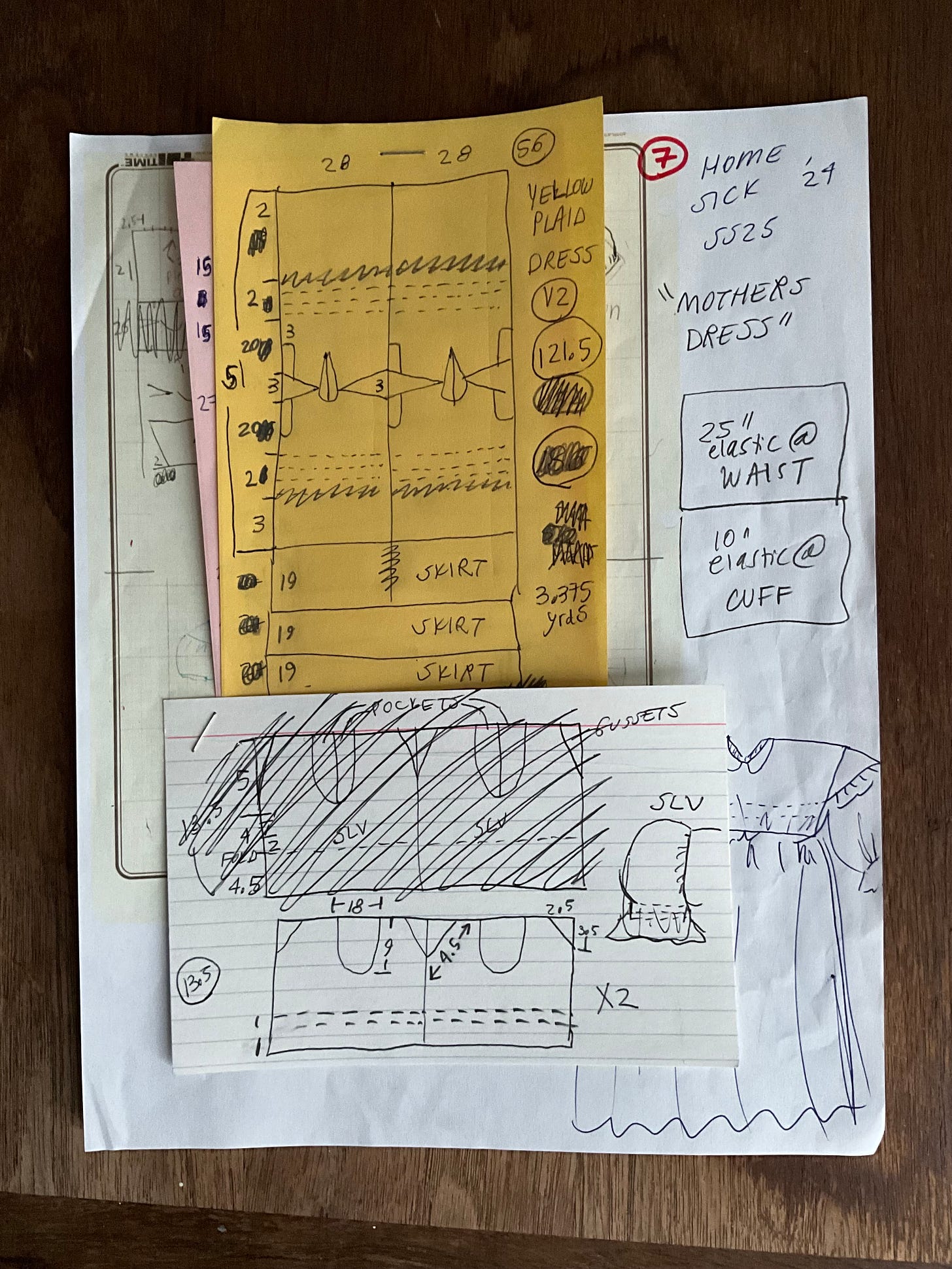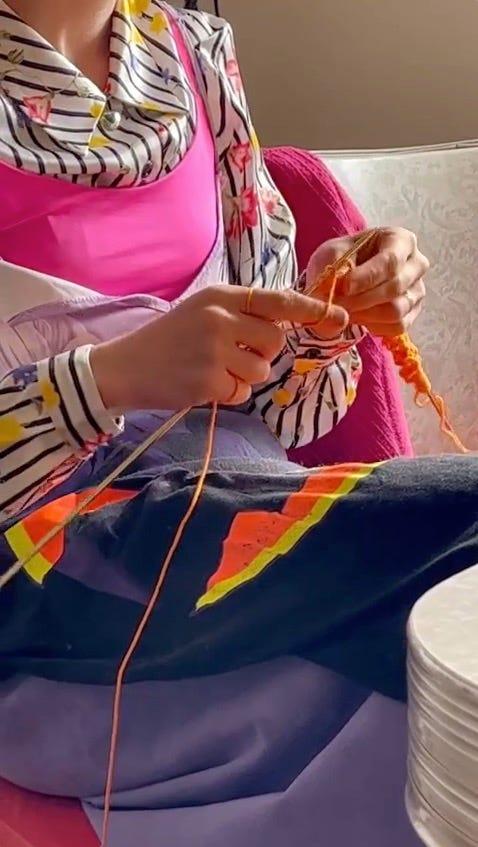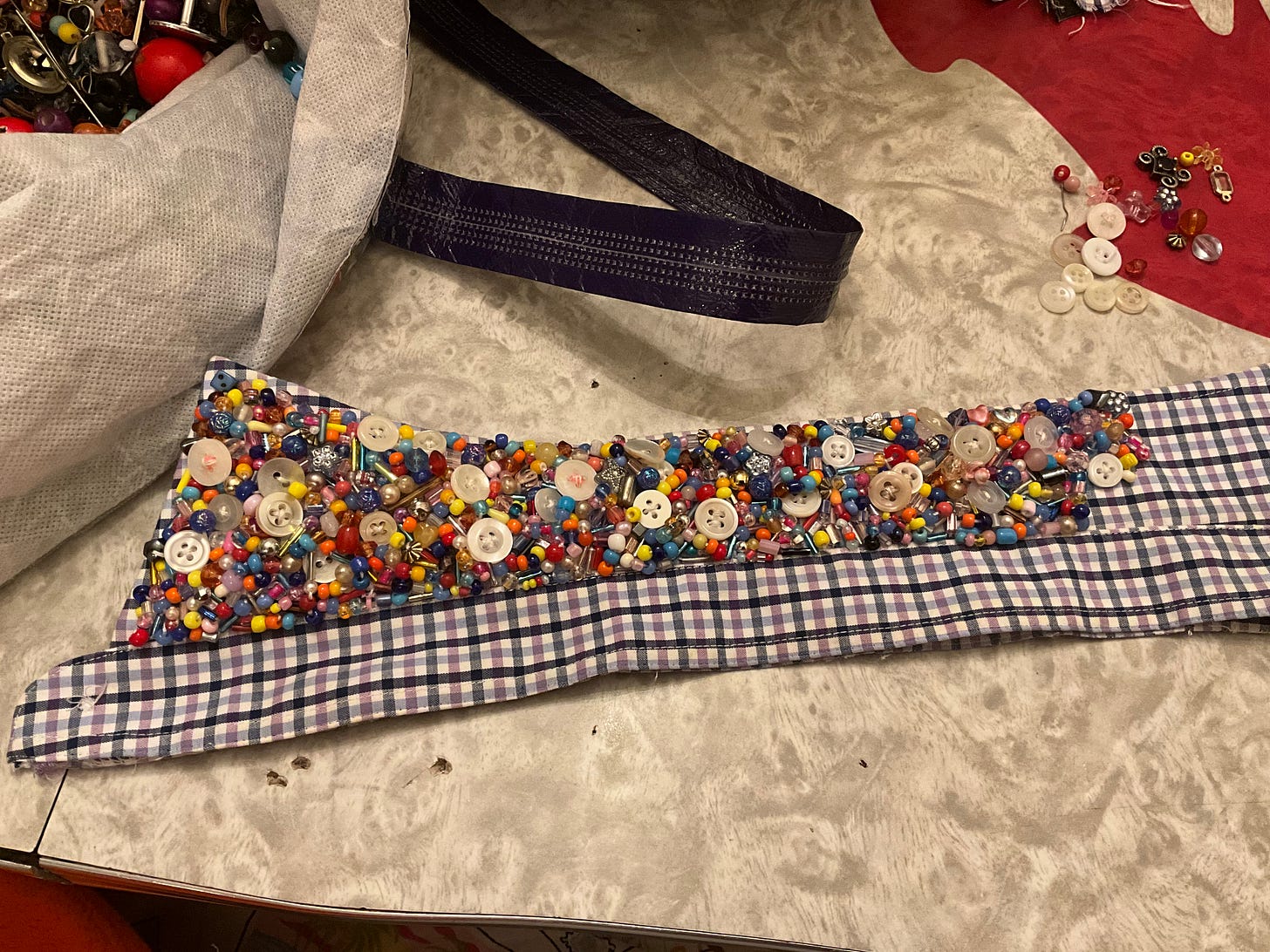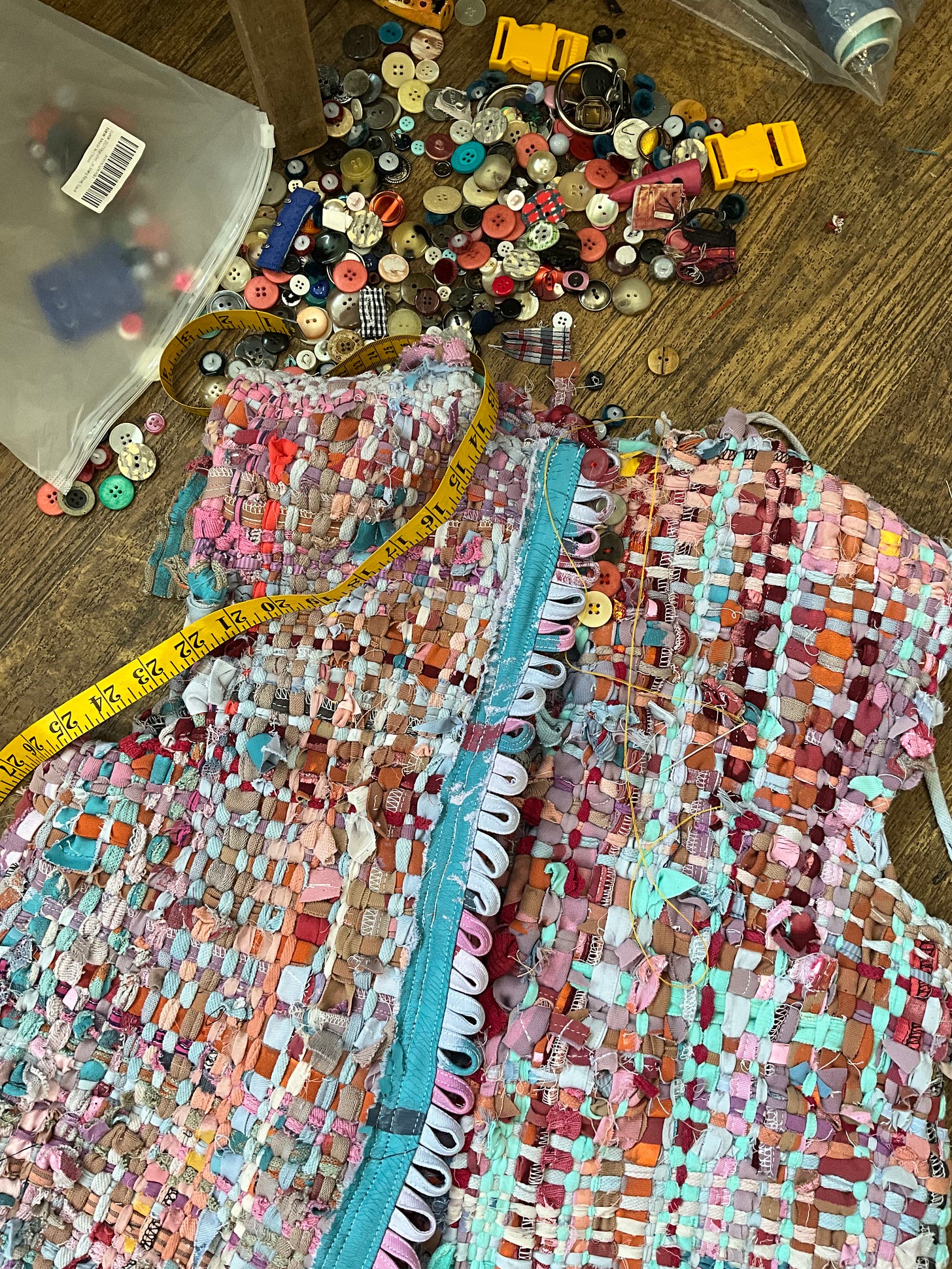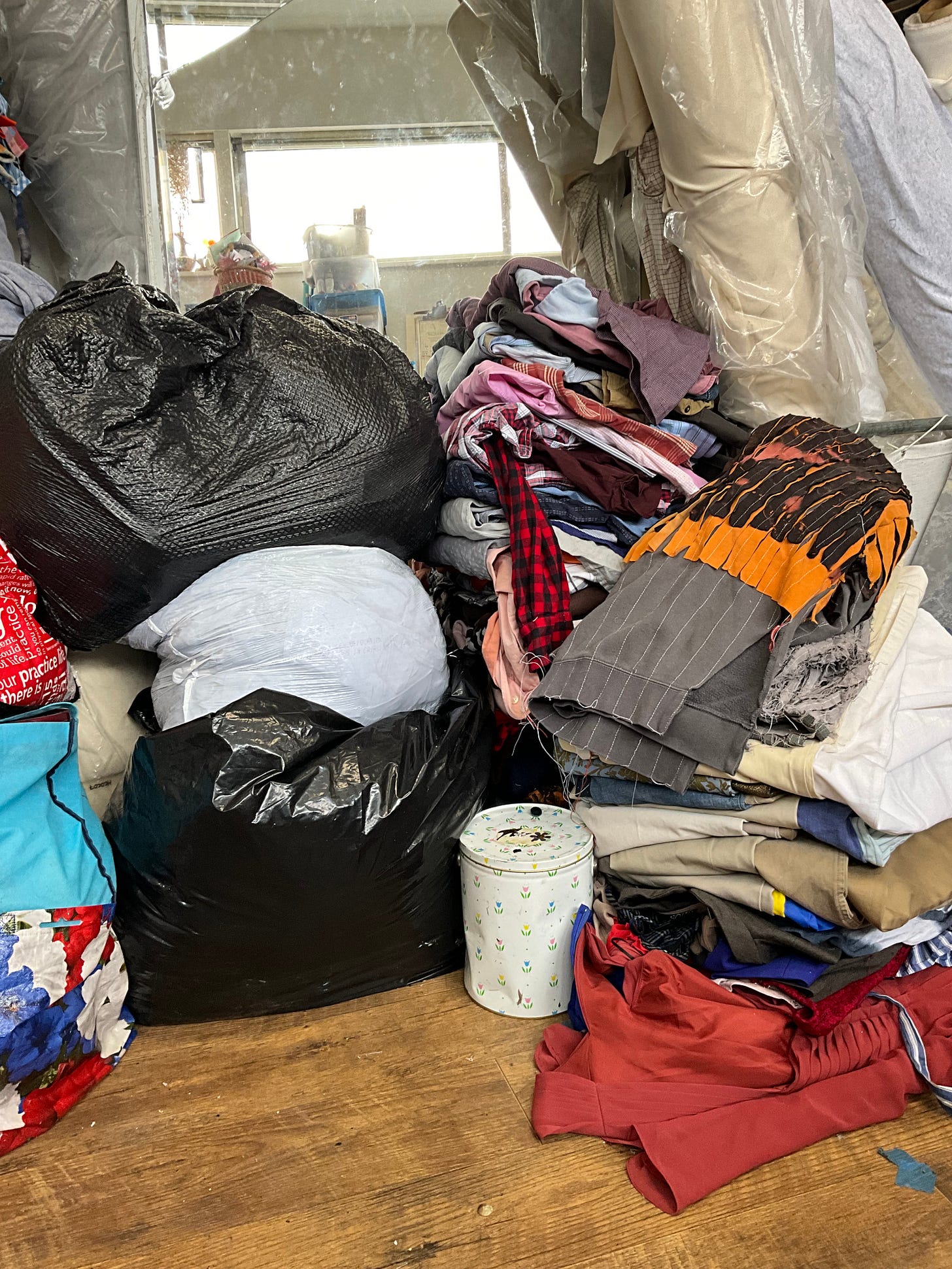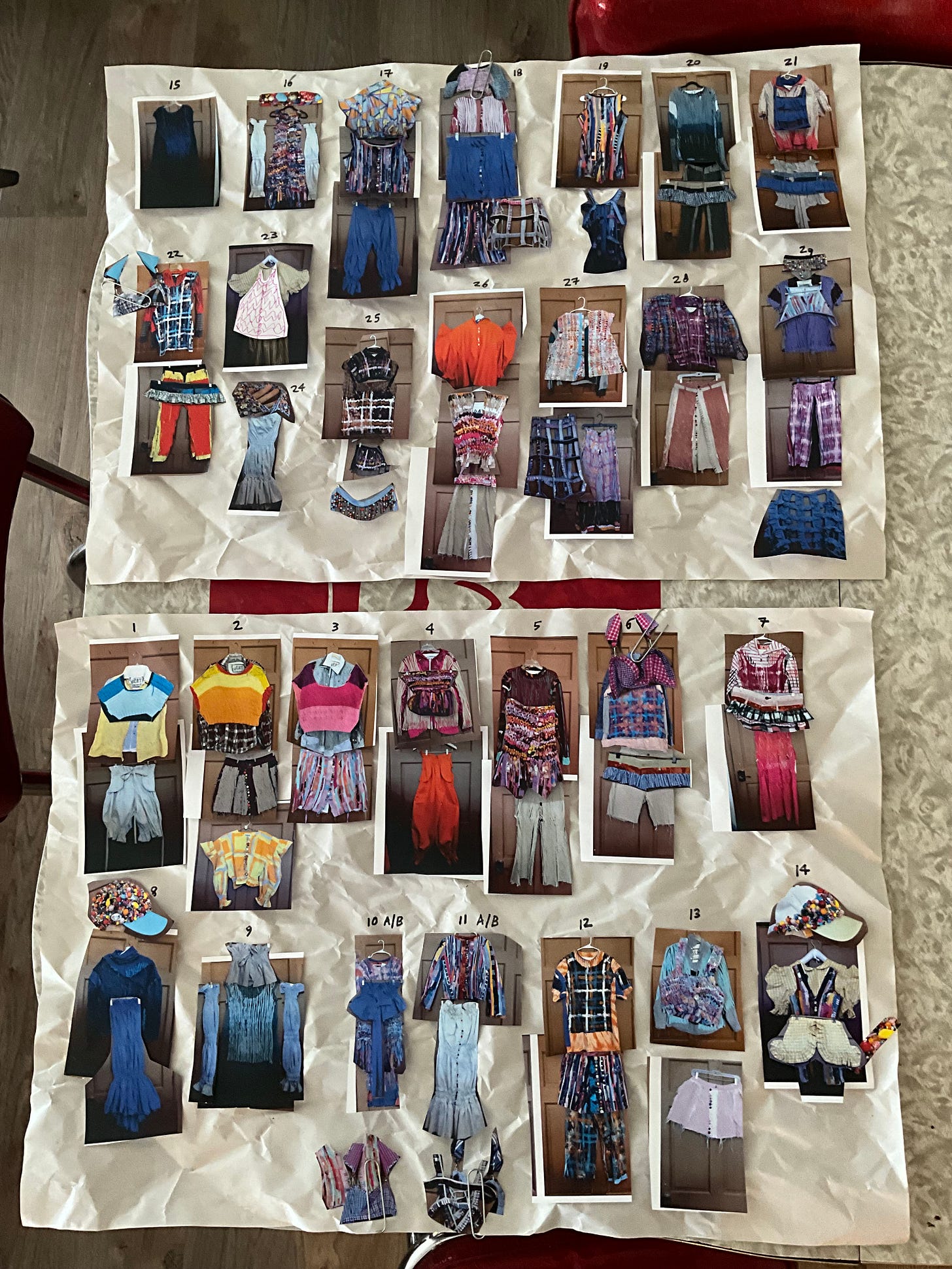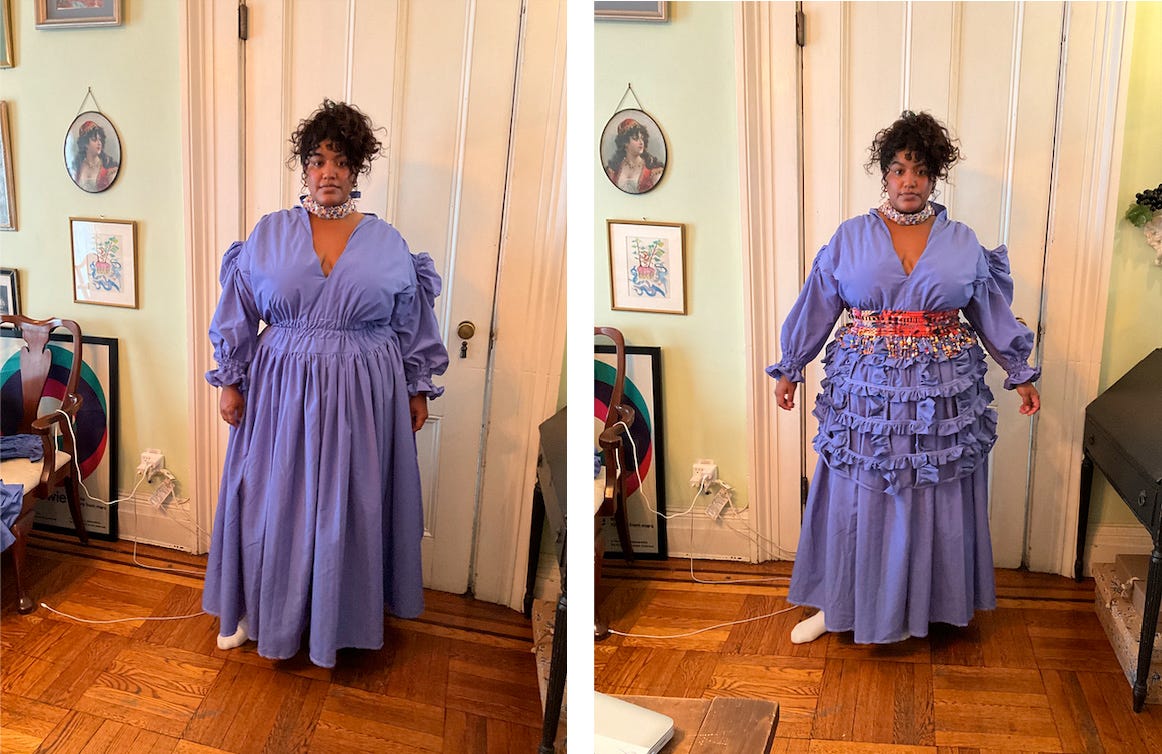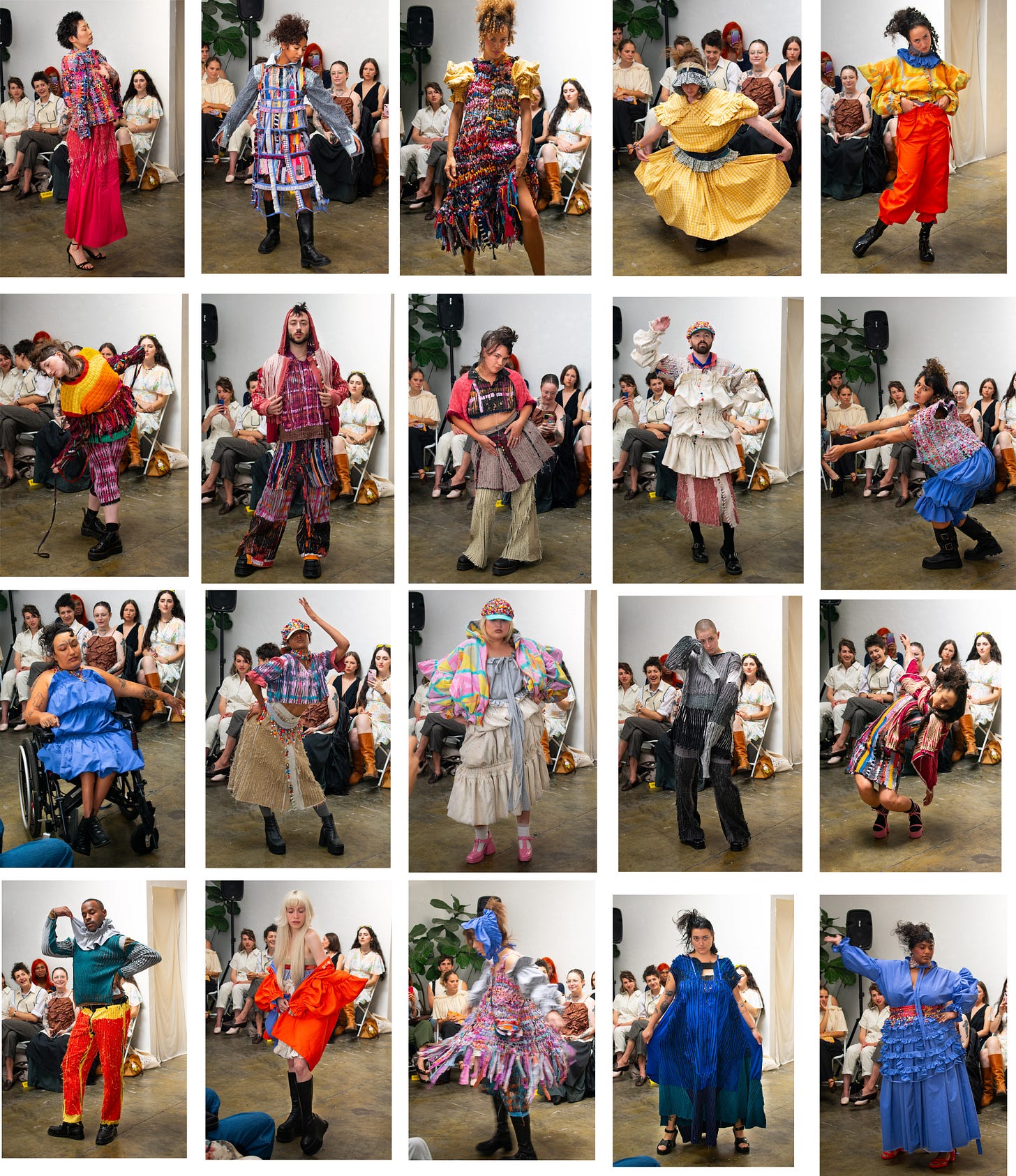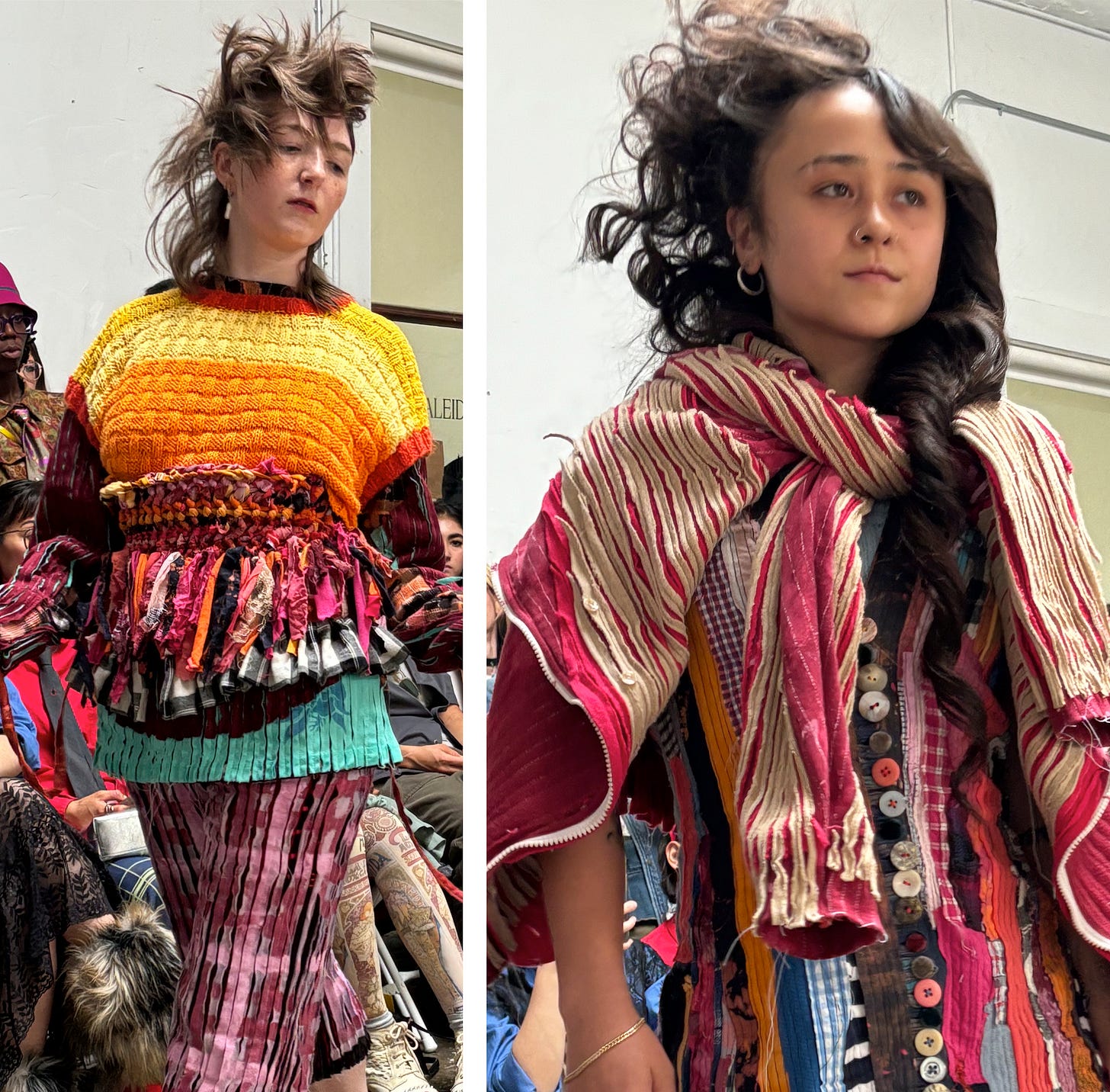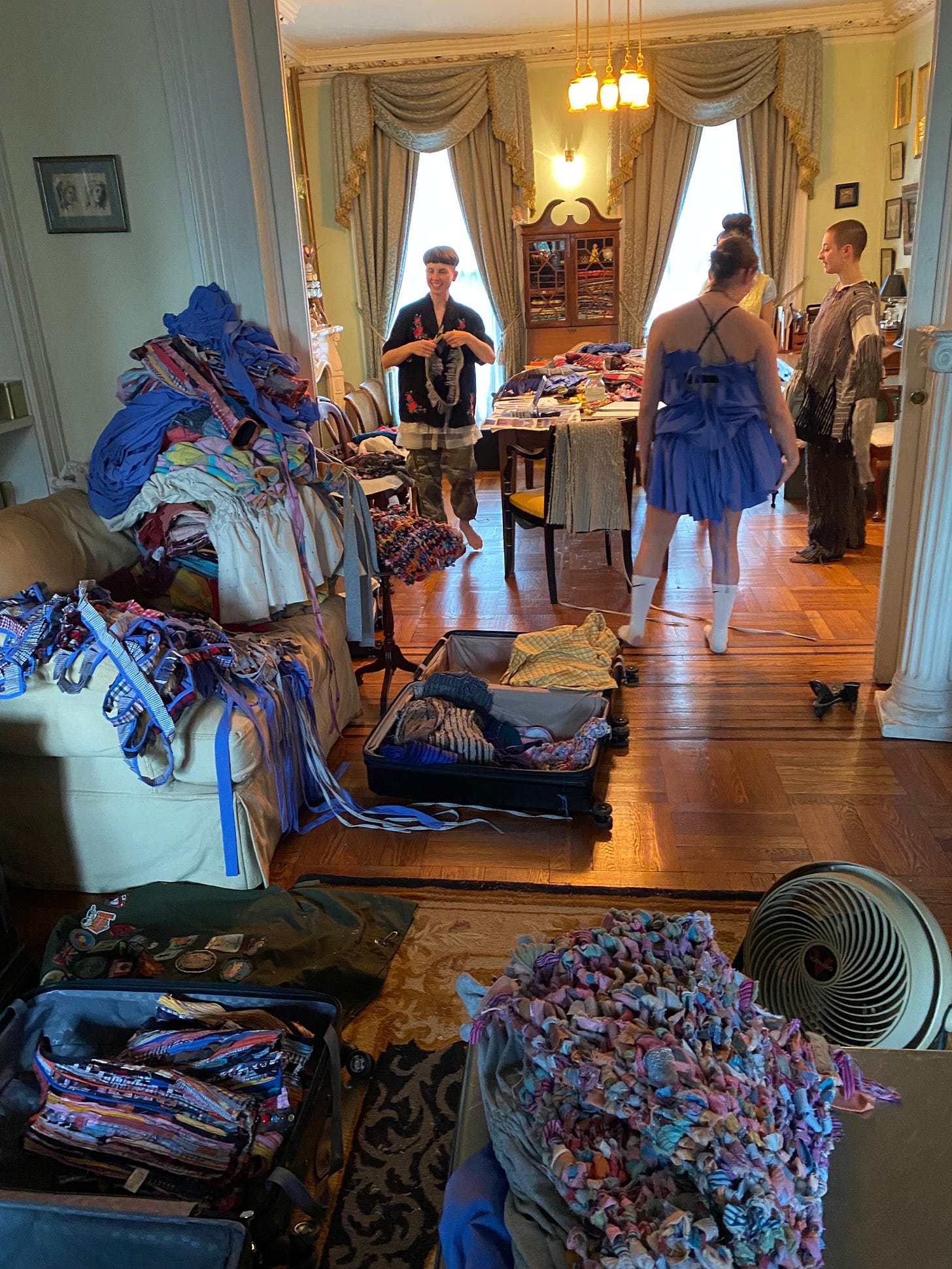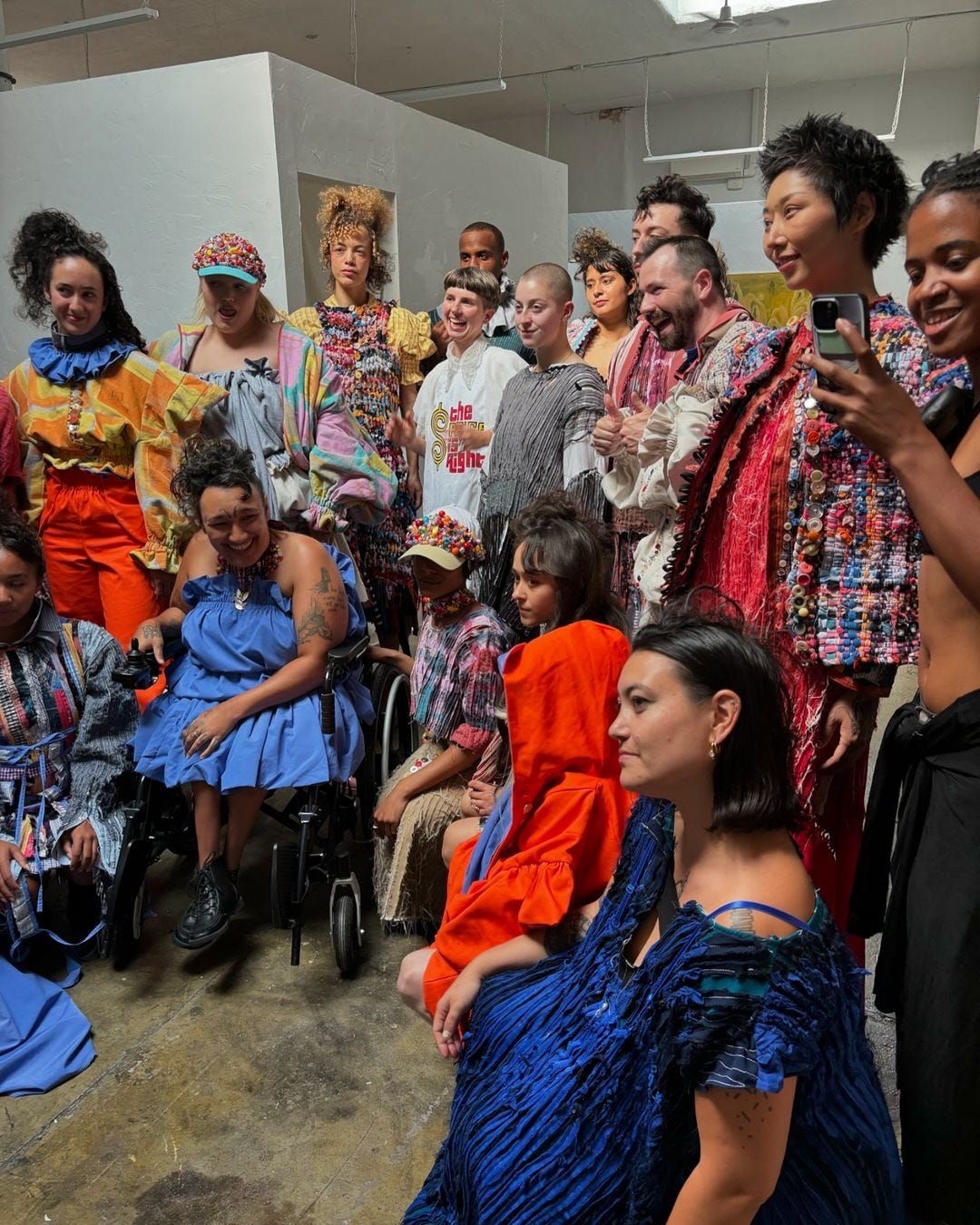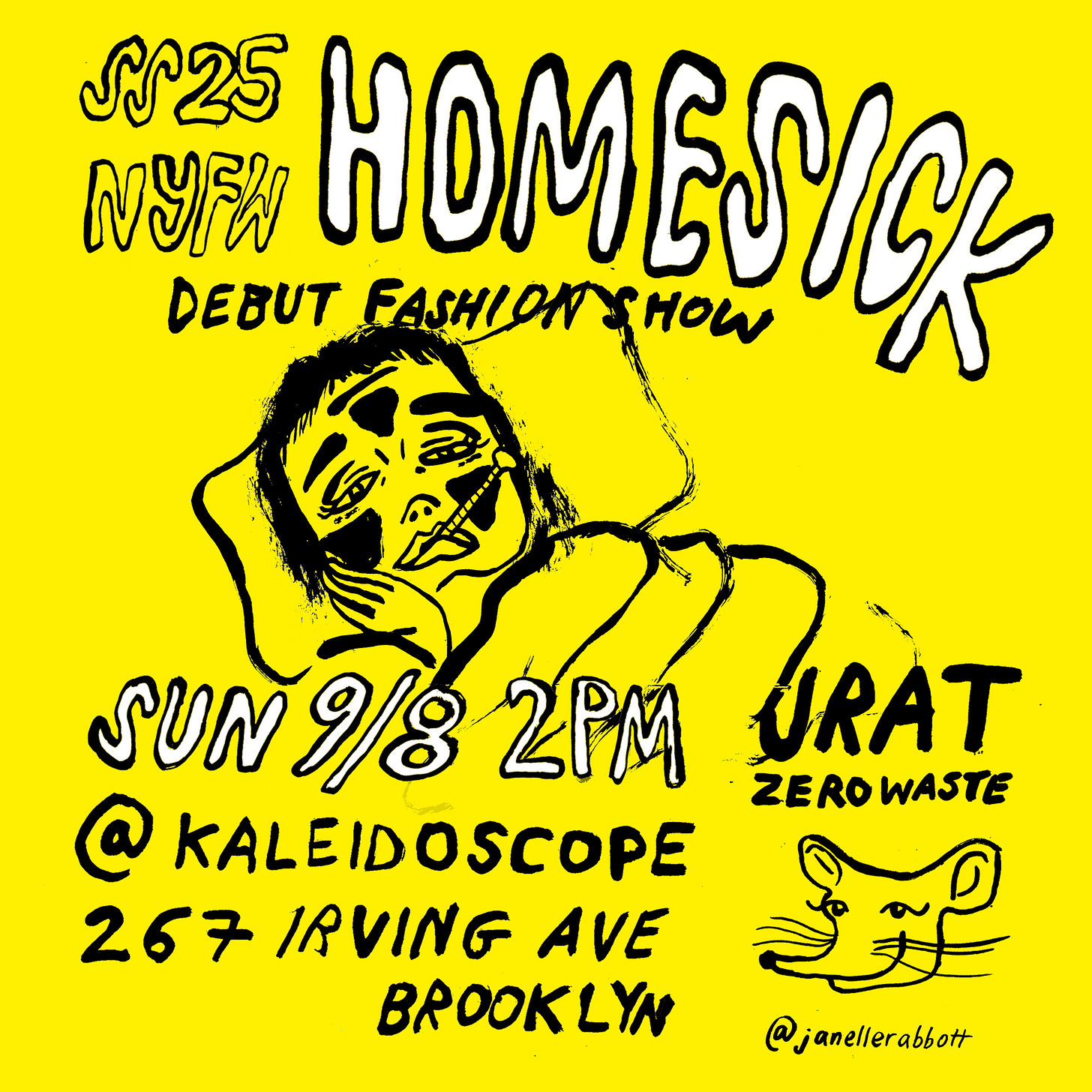All About The Making of JRAT’s SS25 HOMESICK Collection
One month ago, on September 8th, 2024, I made my NYFW debut with the presentation of HOMESICK at Kaleidoscope Studios in Bushwick, Brooklyn. In years past, I’ve participated in group shows with the babes of Bleaq, presented work like Helen Ramona in the Art To Ware storefront, and once was even named one of Teen Vogue’s “Emerging Designers” in a NYFW event, but never before have I presented a full collection, solo, in the form of a catwalk. It’s something I’ve been working towards since 2020 when JRAT became my full-time job, after the pandemic demolished my tenuous compilation of financially supportive gigs.
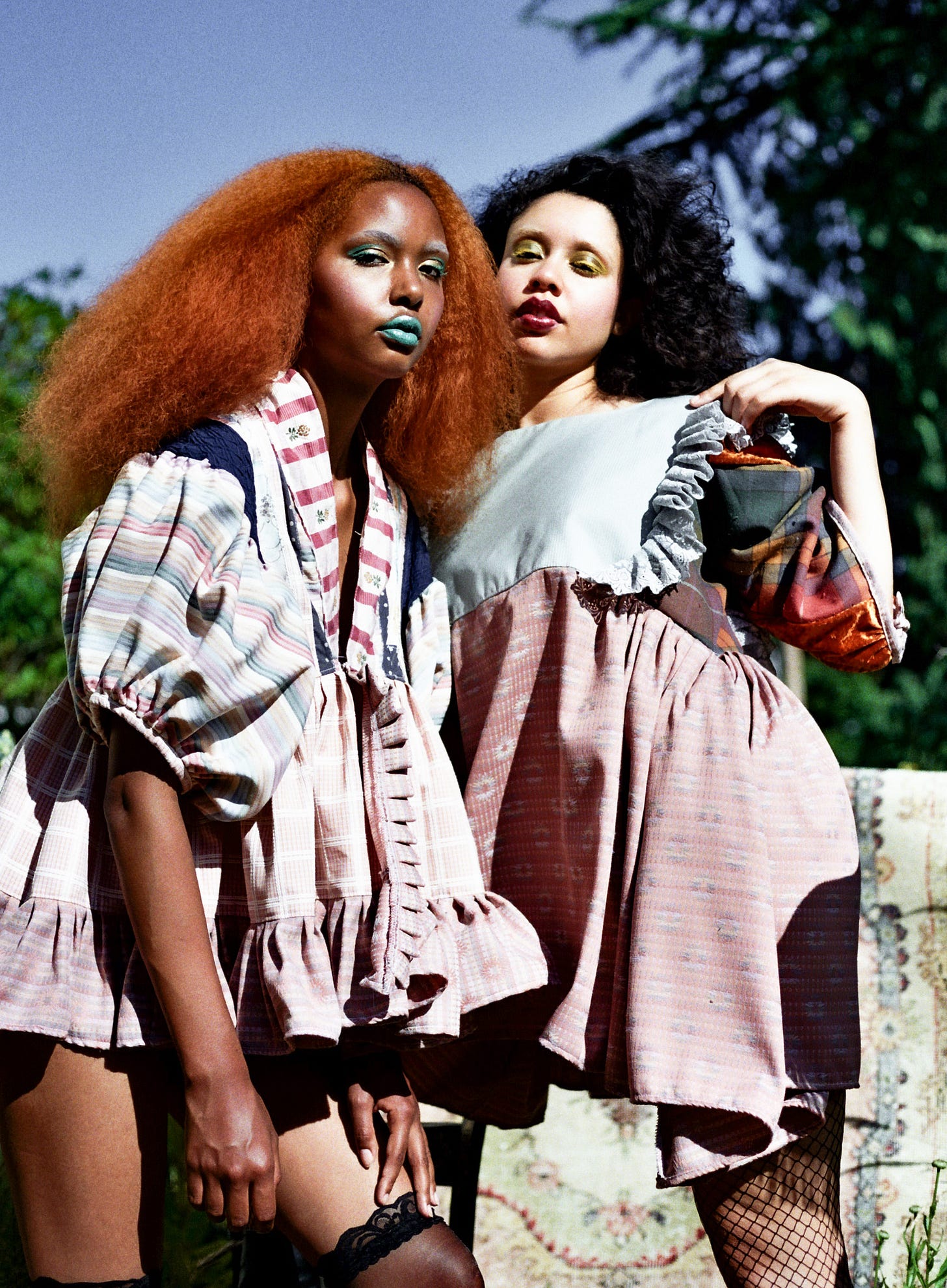
I had actually started out 2020 planning and organizing a solo fashion show at Seattle’s Love City Love in the defunct Seattle Curtain Factory, from whose basement I had sourced a great deal of my deadstock material. That fashion show got shelved when Covid restrictions came in like a bulldozer, so I’m incredibly grateful to have finally accomplished this mile marker in my career only 4 years later, with work much richer and more dense (literally and figuratively) thanks to all of the effort I’ve invested into my practice and process in the interim. There was even a bolt left from that curtain factory that found a home in HOMESICK.
Inadvertently, I began working on HOMESICK when I started the Channel Changer series in 2023. Channel Changer was a fever dream inspired by 90s television. Originally, I had planned for the series to be presented in three parts—Part 1: the embodiment of television static, Part 2: in reference to Clueless (a series that continues to influence my personal style), and Part 3: a celebration of Frasier (my BFF). I collected, processed, and prepared material for each part. Processing included: hand dying and painting textiles with a variety of “as if” influenced plaids; other materials were bleach and paint splatter to evoke the ephemerality of Seattle grunge.
Due to time constraints, however, I only ended up using two out of the three groups of materials to create Channel Changer P1 and P2, worn by 10 dancers in a performance choreographed by Alyza DelPan-Monley and scored by Keyes Wiley which debuted in the Fashion District at Seattle’s Bumbershoot festival in September 2023.
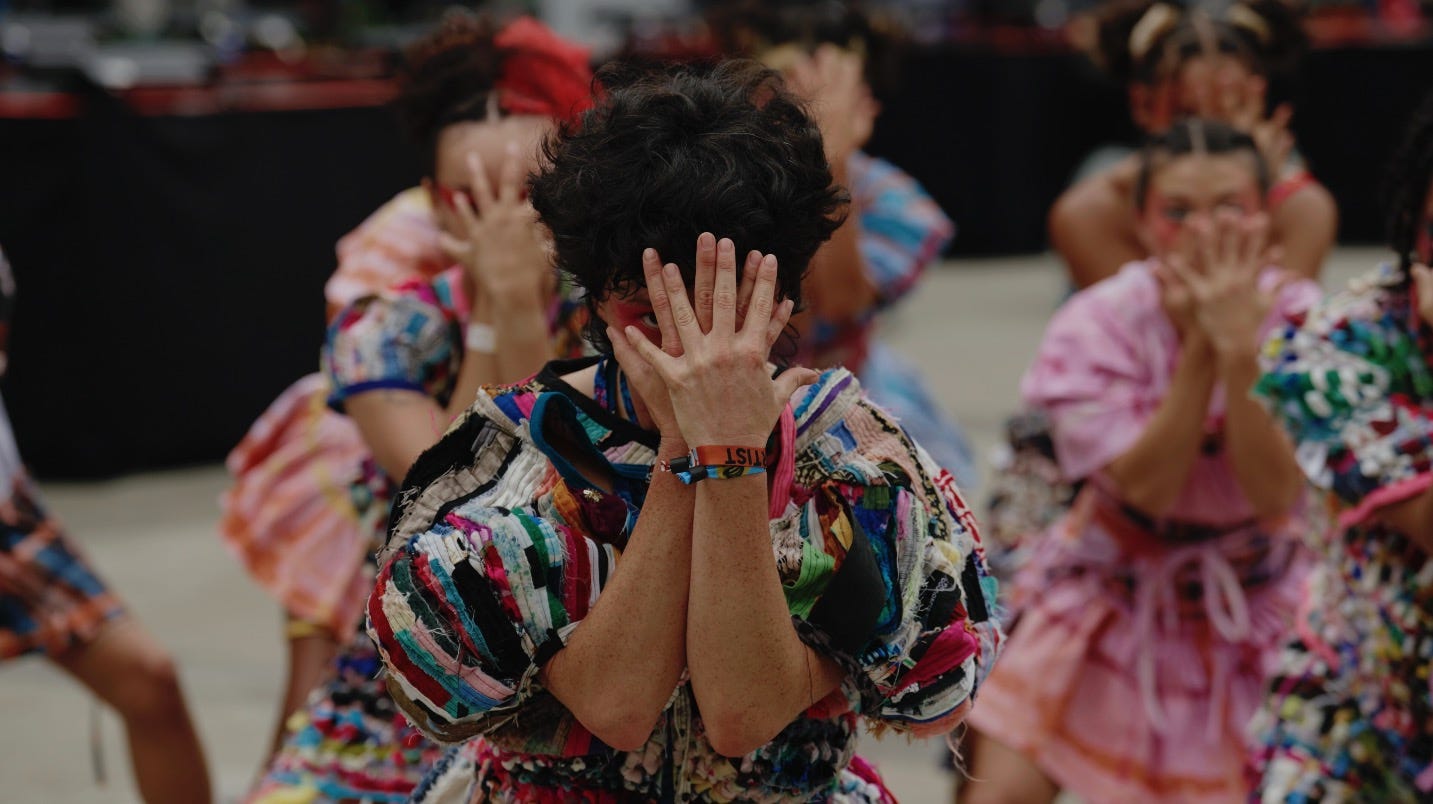
I was really happy with the Channel Changer series within the context of the dance performance. (You can watch clips from the performance here and here.) Alyza did an expert job embodying within the choreography the concepts underpinning the collections, all of the dancers contributed so much beautiful energy to the show, and the soundscape scored by Keyes was exceptional. But some of the garments, individually, I found to be disappointing. It’s not uncommon within my practice that I create, show, and even sell pieces that I am dissatisfied with. I’d go so far as to say that I consider some pieces I’ve let loose into the world to be abject failures compared to my hopes for their outcome during the creation process. What’s been interesting, however, is how many times folks go out of their way to tell me that these pieces are their favorites, not knowing my disdain for them—and how often I watch my favorites drop DOA based on public opinion. (This played out with HOMESICK too, which I’ll get to later.) My goal in creating a collection is to produce work that is the most authentic to my creative voice at that moment, while adhering to my zero waste convictions. So if a garment that I dislike exists to help me resolve my materials and keep the work zero waste, then so be it. There were pieces from Channel Changer that I nonetheless slashed into strips and fed into the HOMESICK scrap mix. I view this process of shredding and recycling old work into new collections as a kind of “textile sourdough starter” which only adds depth to the look, feel, and concept imbued within the final product.
At the end of September 2023, I went to Alexa Stark’s Waldoboro Inn in Waldoboro, Maine for a week-long artist residency. I spent my time at Alexa’s studio, trying to make sense of all the leftovers I had brought with me—failed Channel Changer pieces, half finished garments, chunks of clothes and painted textiles, materials I had processed for CC P3. Some of these materials I cut into strips, sewed into yarn, and woven on the dress form. Others I sewed into new garments then cut into strips and sewed into yarn. And others I just stared at, then shoved back into my army rucksack—which didn’t make my connecting flight on the way home (par for the course of 2023). Already that year I had been robbed in my studio parking lot, locked in the building three different times because the interior lock kept FALLING OUT of the front door (the only exit to the building, other than my window which is how I got out twice in order to climb down a chain link fence and unlock the front door from the outside), the one time my husband came to help me get out of the building when I was locked inside, he got robbed too, and I was mourning the loss of my grandmother on top of it all. Thankfully, the day after I arrived back in Seattle, my rucksack was delivered to my apartment by the airlines. It gave me some semblance of hope that the curse of 2023 was being broken.
All these post-Channel Changer materials were shelved, as I shifted focus to other projects with the start of the new year. Nine months later, in July 2024, the HOMESICK construction process started in earnest. I had 7 unfinished pieces from Waldoboro, and by the end of August 2024, I had completed those, plus 93 more. My superpower is speed. In second grade, I remember Mrs. Ashley at a parent-teacher conference tell my parents, “she’s very fast” (but I don’t think she meant it as a compliment). I didn’t take my time and contemplate my creative decisions as other kids did; I just acted, and by her impression, it made me sloppy. To me, it made me distinct—I could act, finish, and move on to the next project before other kids even got started. That hasn’t changed. I finished my senior thesis at Parsons an entire semester early. Today, my speed is the reason why I’m able to keep my business afloat. I create from a place of decisive action, choosing not the path of least resistance, but the path of clear discretion, which allows me to achieve my aesthetic goals because they are based on my ethical convictions. That’s why my work looks the way it does, why it’s composed the way it is, and why it’s always aesthetically shifting yet exactly the same. I work from a method and a process, not a vision, and that’s exactly the space from which HOMESICK emerged.
The HOMESICK Process
JRAT’s SS25 collection, HOMESICK, emerges out of fond memories of miserable moments--staying home sick from school—under the loving care of mid-90s daytime television (talk shows, games shows, informercials, and all).
HOMESICK is a comforting mirage to snuggle up with, when facing the intolerably bleak nature of the future before us.
In the same way that memories are an amalgamation of recollections, the garments of HOMESICK replicate the slashing and splicing of the memories in one’s mind, but in textile form. Pillowy silhouettes contrast with these shredded surfaces to swallow the body in a safe, protected embrace.
In no way haphazard, the hodge-podge of materials, textures, and colors that comprise HOMESICK are intentionally and personally curated from found, reclaimed, and deadstock materials by the artist behind JRAT, Janelle Abbott.
HOMESICK finds solace in the blissful self-deception that nostalgia manifests.
Step 1: Foundations
I GATHER materials from all kinds of sources—friends, followers, family, free boxes. Occasionally I thrift for specific items, but I prefer happenstance as my main sourcing method.
These materials I ORGANIZE into specific groups. T-shirts and other jersey knits get shoved in one bag, white and black garments get their own bags, and in the case of HOMESICK, I was collecting plaids, khakis, button ups, business casual attire, lightweight knit sweaters, and of course everything left over from Channel Changer. Additionally, I had bolts of deadstock sourced from the Seattle Curtain Factory, Prairie Underground, a Craigslist free section find, and Nick of Time, an online deadstock retailer where I had impulsively bought 600 yards of fabric during a 50% off sale (highly recommend). I pulled in this grouping because they allowed for easier applications of zero waste patterning, as well as opportunities to add additional elements like hand painting to evoke the concept of the collection.
PREPARATION of these materials can include things like dying, painting, bleaching, embroidery, and other textile manipulations such as cutting textiles into strips to create yarn for knitting and weaving.
Step 2: Applications
Once I’ve got the foundation of the collection set by gathering, organizing, and processing my materials, I begin applying different textile manipulations to these materials which included the following methods within HOMESICK:
FULLY FASHIONED WEAVING
I create looms on large pieces of plywood, using nails or screws placed strategically in the shape of each garment pattern piece. In the same way that a fully fashioned sweater is knit into the specific shape of the arm and neck holes, fully fashioned weaving produces garments that address the 3-dimensional form. In advance of this technique, I must create yarn as previously mentioned by cutting and sewing fabric strips together, end to end.
SOUMAK WEAVING
The dress form is used as a loom—I warp it up by pinning strips of fabric around the body, then weave around the dress form by looping the weft around each piece of the warp. The effect appears knit or crochet, as it has a stretch, but these pieces are indeed woven.
SEWN SCRAPS
When I take apart a garment that has a lining, I save it to use as a backing for my sewn scraps method. Because lining is often made from cheap polyesters, it doesn’t have face value in garment reclamation—but these materials still exist, so sewn scraps is a method I developed in order to validate the existence of the lining while honoring its traditional garment shape. Cut strips of fabric are sewn onto the lining, piece by piece, side by side, in order to create a whole new textile. They are edge finished and for HOMESICK, many utilized dozens of loops and buttons as closures. The interior of these garments is not lined in order to expose and celebrate the extensive labor required to create material of this nature.
THE 3T METHOD
Developed as a way to resolve the immense amount of t-shirts I inherited from my aunt when I assisted her in purging her wardrobe, the 3T Method compels individuals to wear more garments simultaneously by combining 3 different t-shirts into one. For HOMESICK, I wanted to explore how this method could expand from jersey knits into wovens, and thus better express the nature of chenille (which is the original inspiration for the method). Garments are dissected, like pieces are stacked, sewn vertically, the top two layers are cut, then the garment is reassembled. Wovens were washed to express the fraying edges.
ZERO WASTE PATTERNING
I learned this method my junior year at Parsons and never looked back. There is no other means of pattern drafting that I adhere to—zero waste patterning is my only way. Pattern pieces fit together like a puzzle so that nothing is wasted, whereas traditional garment patterning wastes 15% of all material. Zero waste pattern drafting says the penultimate form is the garment; the marker, where all the pattern pieces are laid out to be cut from the fabric, that is the true ultimate form. For the zero waste patterned pieces in HOMESICK, I wanted the aesthetic to look and feel like a body swallowed up in puffs and folds of sheets and blankets.
KNITTING
My mom taught me how to knit as a child, and though it’s not a method I always incorporate within my collections (mainly because it’s time intensive), it was something I wanted to utilize within HOMESICK for the sake of evoking that sense of fondly recalling childhood frustrations from an adult POV.
BEADING (AND BUTTONS)
Before my grandmother passed, she and my aunt would buy vases full of beads and broken jewelry at Fabulously Frugal, simply to sort through them as an activity. They would then give to me whatever was left over: which was A LOT of beads. I’ve been using them throughout my collections since 2020, but for HOMESICK I actually wanted to reference beading work I had done back in 2012.
The buttons were both a functional and aesthetic decision. For some reason I thought it would be more time efficient to make button loops and keep them connected when inserting them into the garment, so that there would be a dense row of buttons on the other side. But this meant I was sewing dozens and dozens of buttons onto garment after garment, but thankfully, I didn’t run dry of buttons (and still have so many left over) because my mom gifted me her giant bucket of buttons, I had buttons saved from previously deconstructed garments, AND I had inherited more buttons from an estate sale this past summer.
Step 3: Fulfillment
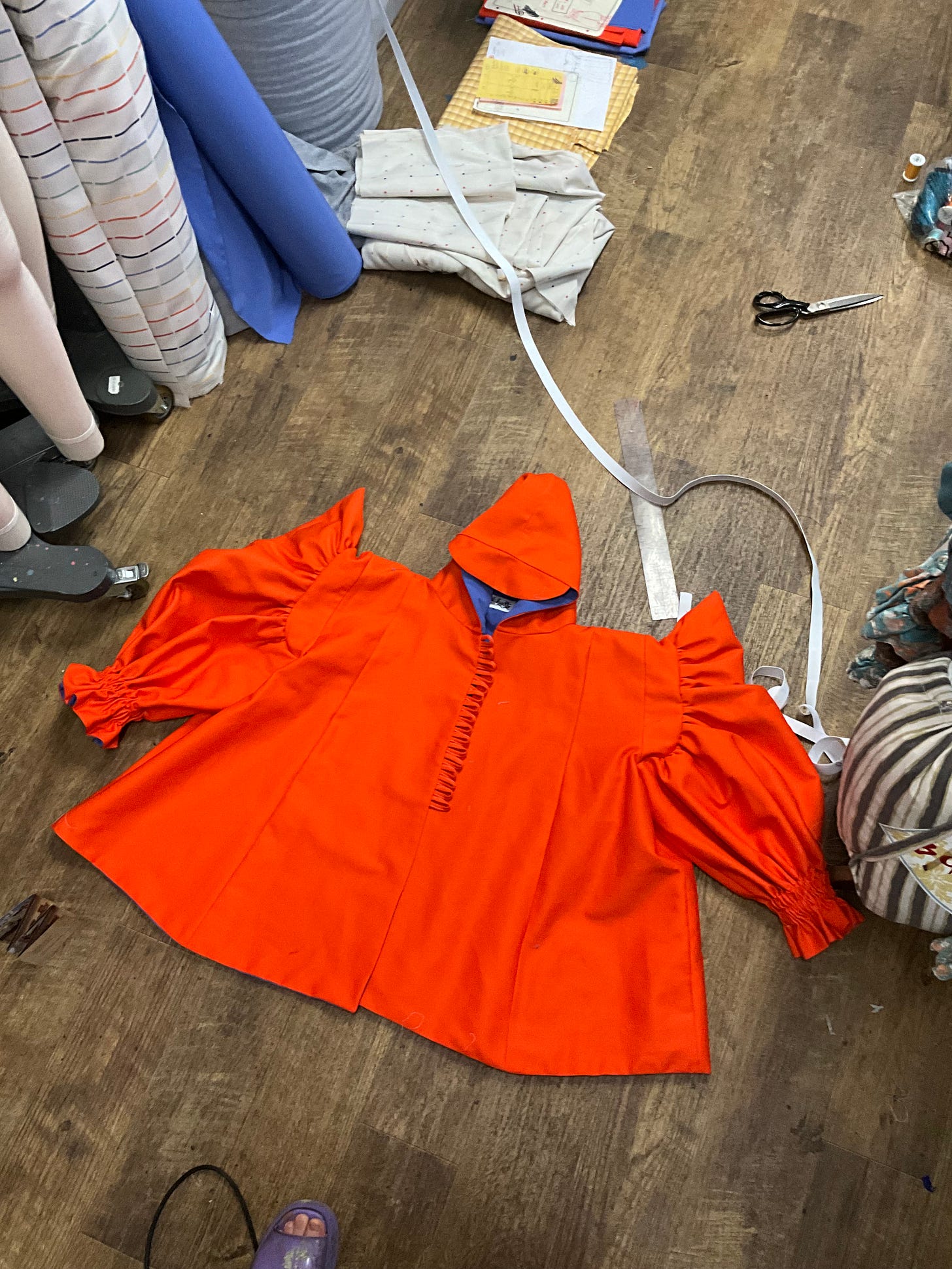
Once all the materials I’ve gathered for have been utilized, then the collection is complete. At various points throughout the construction process, I will assess and begin to make intentional merchandising decisions; if I’ve made too many tops, I’ll start making more bottoms. If I don’t have any dresses, I’ll focus on that. For HOMESICK, it became about creating variations on color and size of the same piece—such as with the 3T variations, I made a long button front skirt in khakis and one in pinks. A 3T style pant in dark tones, one in oranges and yellows, and one in khakis. When I realized I was lacking outerwear, that’s what I started focusing more on zero waste patterning and incorporated the Price is Right inspired painted textiles into the collection. Since I had not met many of my models for the runway in person, I needed to be confident that I would have enough work to dress everyone, no matter their size. This motivated me to make as many pieces as I did.
Step 4: Iteration:
Sometimes, I don’t have the time immediately available to use all my materials (as was the case with Channel Changer, as was the case with HOMESICK). Creating HOMESICK put a button on Channel Changer, and now that the construction for HOMESICK has been completed, I have already compiled materials for HOMESICK P2, including a bag of scraps and seams which will be that textile sourdough starter from the first iteration for the next. The final step in every JRAT collection is: Go again. Again. Again. Again. I have more ideas, more unfulfilled opportunities, and an endless slog of materials. So again. Go again. And again.
The HOMESICK Presentation
One day before flying out for NYC, I shot HOMESICK with one of my favorite Seattle photographers, Ripple Fang. This was my one opportunity to style the collection, as I planned to relinquish control to recent Parsons grad, Yetunde Sapp and her friend Massai, to style the show for NYFW. So long as I have one opportunity to style and shoot a collection, I feel my full vision has been fulfilled. From that point forward, I am open to any stylists, photographers, videographers, or even models to take initiative in curating pieces and styling looks. The truth as I see it is this: once my garments exist, they are outside my control. They are going to be purchased by strangers and incorporated into pre-existing wardrobes, styled with pieces I’ve never known and worn in ways I’ll probably never see. So why try and hold onto the illusion that I have the ultimate say in how my pieces should be worn? You want to wear the dress backwards? Go for it. Should that belt become a collar? Why not!
During fittings, Yetunde and Massai put the lovely Veronica in that one garment from the collection which I despised—yet everyone else loved. My disapproval of the piece (the dress pictured above) came from the fact that it was the last thing I had made for the collection, it had construction issues that I could only resolve in a sloppy way, and I ultimately wanted more time to work on edits in order to bring it closer towards being that thing I hoped it would be. Yet when Veronica put it on, it looked gorgeous. I made it known how I felt about the dress, and let it walk anyway. And everyone at the show loved it. The things that I loved, like the hand knit sweater vests—yawn. Footnotes. At least my BFF Skaidra agreed with me that Ellen had the best look of the show, which was probably the only look that I really had the most say in styling. So at least one person agrees with my taste!
The models for the show were a mix of friends I had worked with before and personally invited including Angel, David, Veronica, Sarah, Bryan, Neve, Midiya, and Sideara. Some were new friends and friends of friends like Flora and Ellen. Haley, Madison, Sophie, Laila, Dylan, India, Valentina, Jayln, and Cristina are all dancers who came to me through a connection with Chris at Haus of PVMNT, as I had done costumes for them several years ago (thank you!). I have a dance background, so I always enjoy working with dancers as models—they know how to embody the pieces in ways that are intimate and expressive. Day of the show, we had a model call out due to illness, but luckily, Neve arrived with a mobility assistant, Sarah, who was willing to walk! Suffice to say, very few of those who walked were “model models” or had even walked a fashion show before. Every human being on this planet wears clothing—even nudist and the few remaining communities in remote jungles—they all wear some kind of adornment or body covering at some point in time. So why not make this simple fact clear on the runway? I wanted the models who walked in my show to represent the kind of individuals I hope will end up owning and wearing my work—Any. One. With. A. Body. Anyone who resonates with my methods and intentions as an artist: they’re all welcome to this party.
Though we had styling appointments pre-show, half the looks were styled day of, all while models were getting ready and Kam Korderz was leading the hair team. We had no make-up team for lack of budget, but also the no-make-up look lent well to the “staying home sick from school” vibes. Kam and I had spoken in advance of the show, but I didn’t provide her with any reference images for how I wanted the hair. ‘Messy bed-head’ was my only instruction, and she knocked it out of the park. Her styling was so outside of my imagination, I was incredibly grateful to have trusted her with implementing her own vision.
As guests arrived, I had a vintage episode of The Price is Right playing over the sound system. Keyes Wiley scored a track for the walk which was inspired by elements of the Channel Changer soundtrack. Zach Thomas and Lu Testa were in charge of photography and my old college roomie, Nina Bowers was videoing as the models walked in a spiral path towards the center of the presentation space before striking a pose and strutting out. Current Parsons student, Zoe Waechter, had come on board as a PA but graduated to Set Designer when she arranged the chairs before the show. The spiral pathway of the models was chosen because of the shape of the space, but it also helped exemplify that dreary, dizzy, sweaty feeling the collection evoked.
JRAT’s Spring/Summer fashion week presentation was held in at kaleidoscope, a bright, airy Bushwick studio where gentle white noise from an old television murmured through a speaker, akin to the sound you might hear from your couch while watching ’90s cartoons as a child. In fact, this nostalgia for being home sick from school – or, as designer Janelle Abbott puts it, the fond memories of miserable moments – is what inspired this delightfully eclectic collection, appropriately named HOMESICK, especially as we often yearn for the simpler days of childhood.
Janelle, who grew up in the fashion industry and understands the labor of love that is making garments, is deeply committed to upcycling, sustainability, handcraft, and zero-waste design methodology. HOMESICK is intentionally curated and crafted from found, reclaimed, and deadstock materials.
Similar to how memories are collected and fragmented, this collection features fabrics that are ripped up, melded together, and reimagined in unique forms and pillowy silhouettes. Woven tweed-like jackets, ruffle collars, and rainbow-beaded hats adorned the cast of models, who slowly meandered down the runway with mussed-up bedhead hair as if just awakening from a dream. With a collection that is made for everyone—and every body—Janelle creates solace through the manifestation of nostalgia.
From “JRAT SS25: A Colorful Amalgamation of Childhood Memories” in No Kills Magazine
After the walk, the audience didn’t know what to do. People just sat there, seemingly stunned. Friends who attended later told me they were on the verge of tears during the walk—all the components of the presentation, from the clothes to the styling to the models to the hair to the movement to the music and on and on, it had culminated with that much power and resonance. I was so grateful to have been received with such willing celebration and joy. I even sold a few pieces at the show, as I was offering everything wholesale (which is effectively half off). I had come to NYC with 200 pounds of luggage so I was eager to move product before returning home! I’m grateful for the reviews of the show from Esque, trendfriends, Sustainable Baddie, and No Kills Magazine, and so thankful for the team who came together to help make the HOMESICK presentation a success. Thank you everyone, audience, models, and crew alike <3 It truly took all of us together to pull this thing off.
And special thanks to Kate who graciously allowed me to stay at her home and take over her dining room for fittings: THANK YOU!!!
To the best of my ability, I will continue to center on the plurality of sustainability within my mission as an artist working within the context of fashion. Through my process and practice, I seek to reduce textile waste by compelling people toward owning and wearing more secondhand clothing and clothing made from clothing. I want to affirm individuals in their most authentic expression through fashion, while advocating for a collective and continued disinvestment from exploitative systems that enslave millions for the benefit of the few. Already, I am looking forward towards creating a brand new collection for NYFW in February 2025. I’ve got half a dozen trash bags full of material, waiting for an assignment. At some point before the end of the year, I also hope to fulfill HOMESICK P2. In the meantime, pieces from HOMESICK are available at Bungee Space, Cafe Forgot, Stand Up Comedy, and my web shop. Please always feel free to reach out to me with requests and inquires. Thank you!
Additional links:
SS25 HOMESICK Fashion Show (video)

